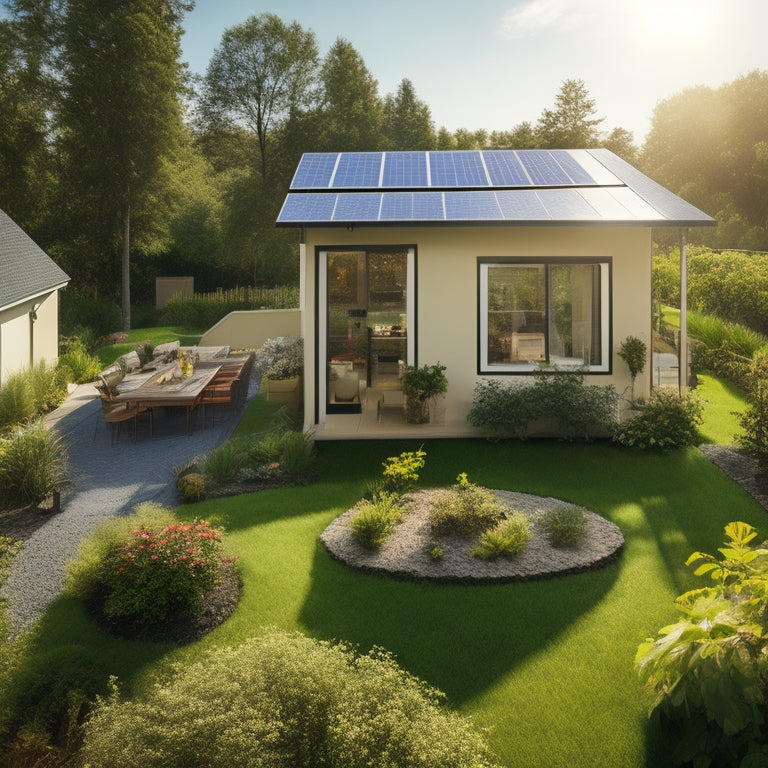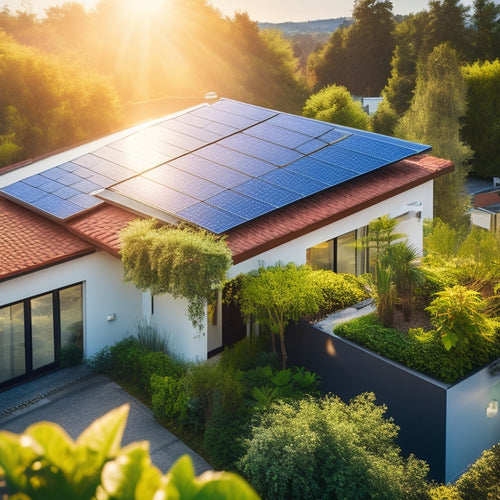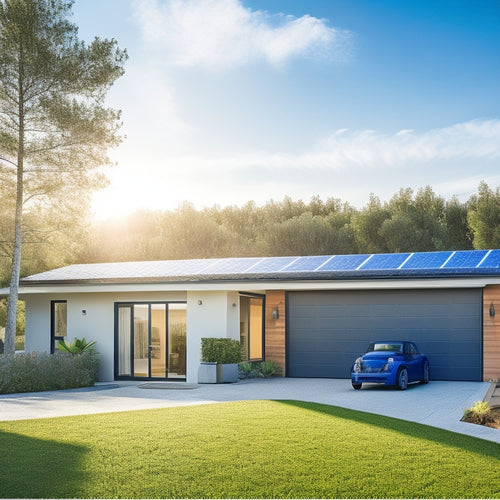
Save Big With the Cheapest Solar Installation Hacks
Share
You're about to uncover a wide range of cost-effective strategies that can slash your solar installation expenses by thousands of dollars. From community solar programs to DIY installations, you can cut costs by up to 50% by eliminating installation fees and increasing energy efficiency. Used solar panels and wholesale deals can also greatly reduce upfront costs. Additionally, maximizing government incentives, optimizing labor installation costs, and exploring alternative financing options can further minimize expenses. By implementing these hacks, you'll be well on your way to generating clean energy while keeping your wallet happy - and there's even more savings to be found in the details.
Key Takeaways
- Community solar programs and financing options can provide 10-15% cost savings compared to traditional installations.
- DIY solar installation can cut costs by up to 50% by eliminating installation costs and increasing energy efficiency.
- Purchasing used or discounted solar equipment from local classifieds, online marketplaces, or recycling centers can significantly reduce installation costs.
- Buying in bulk from wholesalers and negotiating with suppliers can lead to discounts of up to 40% off solar panels and 50% off mounting racks.
- Claiming federal tax credits and state rebate programs can reduce upfront solar installation costs by up to 26% and potentially offer savings of up to $2,500 or more.
Cutting Costs on Solar Panels
Most solar panel installations account for nearly 50% of the total system cost, making them a prime target for cost-cutting measures.
When you're looking to reduce the upfront costs of your solar installation, you'll want to examine alternative solar panel financing options. One approach is to contemplate community solar programs, which allow you to invest in a shared solar array and receive a proportionate amount of the electricity generated. This model can provide significant cost savings, often up to 10-15% less than traditional solar panel installations.
Another strategy is to look for financing options that offer low or no upfront costs. You may be able to secure a loan or lease agreement that allows you to pay for your solar panels over time, rather than all at once.
Some solar panel manufacturers also offer financing options or partnerships with financing companies to help make their products more accessible. By examining these alternative financing options, you can make your solar installation more affordable and start generating clean energy sooner.
DIY Solar Installation Benefits
Your toolbox is about to become a breakthrough in your expedition to make use of solar energy. By taking the DIY route, you'll not only save on installation costs but also gain hands-on experience and control over your solar panel system.
| Benefits | Description | Advantages |
|---|---|---|
| Cost Savings | Eliminate installation costs by doing it yourself | Save up to 50% of total costs |
| Energy Efficiency Upgrades | Easily upgrade your system as technology advances | Increase energy output by up to 20% |
| Solar Panel Maintenance | Learn to maintain your system, reducing reliance on professionals | Reduce maintenance costs by up to 30% |
| Customization | Design and install your system according to your specific needs | Optimize energy output and reduce waste |
With DIY solar installation, you'll be able to perform routine solar panel maintenance, ensuring your system operates at peak efficiency. Plus, you'll be well-equipped to make energy efficiency upgrades as new technologies emerge. By taking charge of your solar installation, you'll be employing the full power of solar energy while keeping costs low.
Finding Cheap Solar Equipment
You'll be surprised at how much you can save by finding cheap solar equipment.
Consider buying used solar panels or looking for discounted wholesale deals to slash your costs.
Additionally, scour local classified listings for individuals selling their used solar gear at a fraction of the original price.
Buy Used Solar Panels
When scouring the market for affordable solar equipment, it's vital to contemplate buying used solar panels, which can considerably reduce the overall cost of your installation.
You'll be surprised at the used panel advantages that come with secondhand sourcing. Not only do you save money, but you're also reducing electronic waste and supporting sustainable practices.
Used solar panels can be sourced from various places, including online marketplaces, solar panel recycling centers, and even local solar installers who may be upgrading their existing systems.
Be certain to inspect the panels thoroughly for any signs of damage or wear and verify they're compatible with your system's requirements.
Keep in mind that used solar panels may not come with the same warranties as new ones, so it's important to factor in potential maintenance costs.
However, with proper installation and maintenance, used solar panels can still provide efficient energy harvesting for years to come.
Discounted Wholesale Deals
Scouring wholesale markets and online platforms for discounted solar equipment can be a goldmine for those seeking affordable solutions. You can snag significant discounts by buying in bulk and negotiating with suppliers.
| Equipment | Discounted Price | Savings |
|---|---|---|
| Solar Panels (100W) | $150 (normally $250) | 40% off |
| Inverters (3kW) | $800 (normally $1,200) | 33% off |
| Mounting Racks | $50 (normally $100) | 50% off |
| Solar Charge Controllers | $20 (normally $40) | 50% off |
| Wire and Connectors | $10 (normally $20) | 50% off |
When you're shopping wholesale, make certain you're purchasing from reputable suppliers to guarantee the quality of your equipment. Don't be afraid to negotiate prices, either - suppliers often have wiggle room to offer better deals. By taking advantage of discounted wholesale deals, you can save hundreds or even thousands of dollars on your solar installation.
Local Classified Listings
Dig up local classified listings online or in print to uncover hidden treasures of solar equipment at bargain prices. You can find community resources like Craigslist, Facebook Marketplace, or local online classifieds where people are selling used or new solar equipment at discounted rates.
You might stumble upon a great deal on a slightly used solar panel or an entire solar installation kit at a fraction of the original cost.
When browsing online marketplaces, be cautious and verify you're buying from a reputable seller. Inspect the equipment thoroughly before making a purchase, and don't be afraid to negotiate the price. You can also post an ad describing the equipment you're looking for and see if anyone in your area has it to offer.
Additionally, visit local salvage yards, Habitat for Humanity ReStores, or non-profit organizations that accept donations of used solar equipment. You might find a treasure hidden among the discarded items.
Remember to inspect the equipment carefully and test it before making a purchase. By digging through local classified listings, you can score some remarkable deals on solar equipment and save big on your installation costs.
Maximizing Government Incentives
You're likely aware that the government offers incentives to encourage the adoption of solar energy, but you mightn't know how to tap into them.
Federal tax credits can greatly reduce the upfront cost of your solar installation, and you can also investigate state rebate programs for additional savings.
Federal Tax Credits
One of the most notable advantages of going solar is the federal tax credit, which can greatly reduce your upfront costs. As a homeowner, you're eligible for a federal tax credit of up to 26% of your total solar installation cost. This credit can be claimed on your taxes, providing a significant rebate on your investment.
Here's how you can make the most of federal tax credits:
-
Claim the credit in the first year: You can claim the full credit in the first year, reducing your tax liability and increasing your cash flow.
-
Save receipts and documents: Keep all receipts, invoices, and installation documents to prove your solar installation cost and claim the credit accurately.
-
Consult a tax professional: Verify you're taking advantage of the credit correctly by consulting a tax professional or using tax preparation software.
- Combine with state incentives: While we'll discuss state rebate programs later, you can combine federal tax credits with state incentives to maximize your savings.
State Rebate Programs
Beyond federal tax credits, state rebate programs offer additional opportunities to slash your solar installation costs. You'll need to check your state's eligibility criteria, as these programs vary widely. Some states offer rebates based on the size of your solar panel system, while others provide a fixed amount per installation.
You might be eligible for a rebate even if you've already claimed the federal tax credit. To take advantage of these programs, you'll need to submit a rebate application. This typically involves providing documentation, such as proof of installation, system specifications, and invoices.
Be sure to review the application process carefully, as missing deadlines or incomplete submissions can disqualify you from receiving the rebate. State rebate programs can provide considerable savings, with some offering up to $2,500 or more per installation.
Reducing Labor Installation Costs
Most solar installation projects eat up a significant chunk of their budget on labor costs, which can range from 10% to 20% of the total project expenditure.
As you plan your solar installation, it's crucial to find ways to reduce these costs without compromising the quality of the installation.
You can negotiate with your installer to get the best deal possible. Here are some labor negotiation tactics and installation efficiency tips to help you save:
- Get multiple quotes: Compare prices from different installers to find the best deal.
- Opt for a smaller installation team: Fewer workers mean lower labor costs.
- Schedule the installation during the off-season: You may get a better rate from your installer during the off-season.
- Consider a DIY installation: If you have the skills and experience, installing some parts of the system yourself can save you money on labor costs.
Solar Installation Budget Hacks
You've optimized your labor costs, now it's time to tackle the rest of your solar installation budget.
It's essential to identify areas where you can cut costs without compromising the quality of your solar panel system. One effective way to do this is by exploring alternative solar financing options. Instead of paying upfront, consider financing your solar installation through a loan or power purchase agreement. This can help spread the cost over time, making it more manageable.
Another budget hack is to prioritize energy efficiency upgrades. By improving your home's energy efficiency, you may require a smaller solar panel system, which can lead to significant cost savings.
Focus on upgrades like insulation, window replacements, and energy-efficient appliances to reduce your energy consumption. Additionally, look for incentives and rebates offered by your utility company or government for energy-efficient upgrades.
Frequently Asked Questions
Can I Install Solar Panels on a Rented Property?
You can install solar panels on a rented property, but you'll need your landlord's permission and may want to investigate solar leasing options; know your tenant rights and negotiate a mutually beneficial agreement.
Are Solar Panels Affected by Shade From Trees?
You're right to wonder if trees will cast a shadow on your solar panel efficiency. Yes, shade from trees does impact solar panel efficiency, reducing energy output by up to 20% depending on the tree's location and density.
Do Solar Panels Require Regular Maintenance?
You'll be relieved to know that solar panels require minimal maintenance, ensuring a long solar panel lifespan. By performing occasional inspections and cleaning, you'll minimize maintenance costs, maximizing your energy output and savings.
Can I Sell Excess Energy Back to the Grid?
Did you know that in 2020, over 2 million homes in the US had solar installations? You can sell excess energy back to the grid through net metering options, earning energy credit benefits, which you can then use to offset your energy bills when you need it.
Are Solar Panels Durable in Extreme Weather Conditions?
You'll be relieved to know that solar panels are built to withstand extreme weather conditions, boasting an impressive lifespan of 25-30 years, with some manufacturers offering extended warranties for added peace of mind.
Conclusion
As you stand on the threshold of your new solar-powered abode, the warmth of the sun on your face mirrors the warmth of the savings in your pocket. By embracing these cheapest solar installation hacks, you've woven a fabric of thriftiness, thread by thread. From cutting costs on panels to maximizing government incentives, every strand of your solar installation budget has been carefully crafted to create a work of art of frugality. Now, bask in the radiant glow of your eco-friendly haven, knowing you've saved big without sacrificing a shred of sustainability.
Related Posts
-

Solar Power Systems for Cost-Effective Sustainability
Investing in solar power systems is a smart move for cost-effective sustainability. You can save about $1,500 annuall...
-

Solar Energy Storage Options for Homes
When considering solar energy storage options for your home, you'll find several effective solutions. Battery systems...
-

Solar Inverter Troubleshooting for Beginners
Troubleshooting your solar inverter starts with understanding its efficiency and performance metrics. Check for prope...


